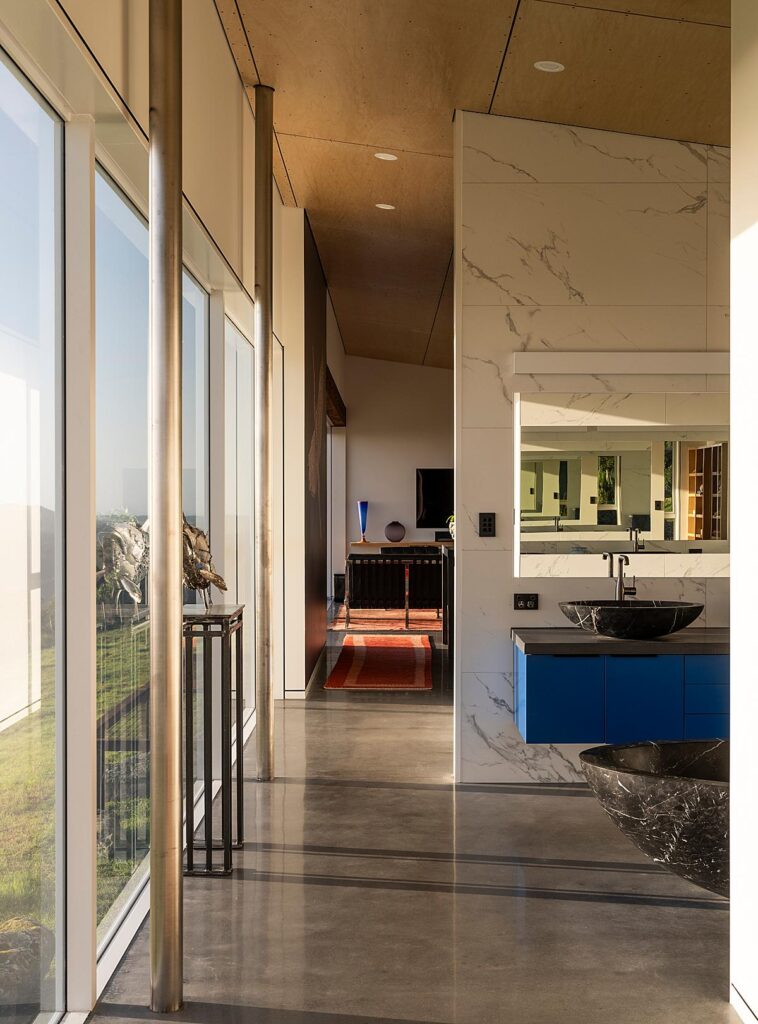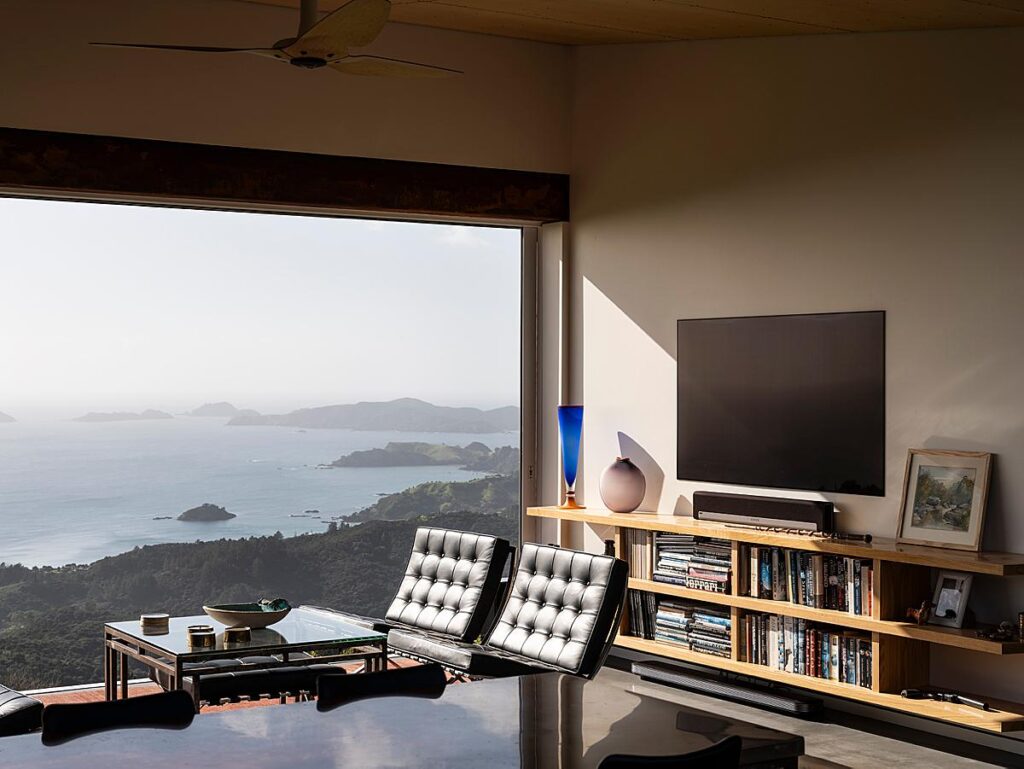David Straight Captures What It’s Like to be at Bret de Their’s Radar Hill House
Welcome to architect Bret de Their’s Radar Hill — a gorgeous home overlooking the Pacific, perched on New Zealand’s Northland’s East Coast. The maker of these spectacular photographs is none other than Auckland-based architectural photographer David Straight, who we are so excited to have back on APA for another Project of the Week!
David starts, “New Zealand is not short of some stunning locations for residential architecture. We’re blessed with some dramatic landscapes. But this one felt unique. The house is located in a remote part of Northland’s East Coast and is situated down a very long rural road, atop a hill, in a landscape strewn with volcanic rocks and native bush. It takes in panoramic views out over the Pacific Ocean.”
Here, a pulled-back view of Radar Hill allows us to see the home in the context of its environment.

He continues, “The property consists of three very different structures. First, the main house is a long, single-story dwelling, glazed along the eastern elevation. The house sits on concrete piles so the house purposefully doesn’t touch the land. The second is a 19m long cantilevered concrete lap pool. This juts out into the landscape like a sort of brutalist sculpture. The third is the barn with solar grid, batteries and storage. The house is completely off the grid – powered fully by the large solar array fixed to the sloping roof of the purpose-built barn.
All three structures employ very different languages and all are quite modest in their own way, though you could rightly argue a 19m concrete pool isn’t exactly modest. But none are shouting above the importance of the landscape.”

David’s next shot gives us a glimpse of Radar Hill’s exterior and interior combined. Through the large glazing, we see hard angular light shining into the house and illuminating the interior. We also get a good look at the piles David mentioned that suspend the home over the ground.

I love this next photograph. The figure leaning in the window showcases the way Radar Hill is designed around showing off and immersing itself in the natural beauty of the landscape.

In this shot, we get a good look at the brutalist concrete lap pool. I love the way David carefully positions this photograph to allow the pool to just out over the landscape and almost converge with the Ocean, making the water in the pool seem to be one with the water in the Pacific. This composition really heightens the pool’s grandeur.

Perhaps my personal favorite image from this project, David displays the rectilinear volume and its open breezeway that seems to serve as a frame for the ocean beyond. The silhouetted figures give scale and purpose to the scene.

I asked David a bit about the shoot day and he shared, “I shot this in the middle of Winter 2022, a week shy of the shortest day, for a local architecture magazine. There are pros and cons of a winter shoot; the days are short, the sun is low and penetrates further into a building, and the light is sharp.
We started at dawn, making the most of the morning light for a northeast-facing site. The enormity of the landscape quickly became apparent as we drove up the driveway. As stunning as it is it also poses the problem of decent vantage points.
Because of the disparate identities of the three structures it often felt jarring to create images that showed them together. They all sit in the landscape in their own ways. So I decided to keep them separate and focus on their specific relationships to the landscape, which really is the main character here. Thankfully I had the whole day to work through the ideas. Jobs like these become a series of moments that tell the story.”

Continuing, David says “I often walk a lot when I shoot. I think my brain engages when I’m moving and I understand the relationship between spaces better when I’m moving through and around them. There is poetry to be found while walking, so I spend a good portion of the day just wandering, watching, and sketching ideas with my camera. I’m often repeating and refining images as I go through the day.”

Here we get a good look at that sharp, penetrating light David mentioned earlier. The crisp highlights and deep shadows lend themselves well to Radar Hill’s rectilinear shape and create a lovely mood.

As the light changes, so does the mood. Soft, gentle light creates a tranquility and peacefulness in the living area that feels so inviting.

“The shoot also coincided with a period of intense sunsets brought about by the climatic impact of the Hunga Tonga-Hunga Ha’apai volcanic eruption five months earlier. The skies were ablaze towards the end of the day,” David notes.

Just look at that perfect sky and the way it lights up the lap pool!

David says, “It’s hard not to feel like you want to be standing in that breezeway at sunset in that beautiful evening light…Ultimately though photography can never truly capture what it’s like to be in a landscape like this. I guess all we can hope is to do is try and capture some of the feeling of being in this place.”
If capturing what it’s like to be at Radar Hill was David’s mission, this series is a massive success. What a stunning and tranquil project!

We’ll close out this project with some wise advice from David for photographers shooting a similar project. He shares, “The only way to learn is by doing, I think. You have to find your own way and probably don’t listen too much to the advice of others. We each experience the world differently, you just figure out what works for you and persist.
I started shooting architecture with a fixed 50mm lens and that’s it. I hate using tripods and half the time I still feel like I have no idea what I’m doing. That constant learning and desire to improve keeps the job interesting. I feel like when I’m shooting I’m in some sort of dance with the building; moving side to side, up and down, round and round. Sometimes it’s beautiful. Sometimes I trip over my feet.
We all love looking at pictures but be broad in what you consume. Instagram can be very narrow. Go buy a Guido Guidi book or immerse yourself in the photography book section of the local library.”
Thank you for this David! You can see more of David’s stellar work via his website davidstraight.net, or on his Instagram @david_._straight.
If you have a project you’d like to be considered for Project of the Week, you can submit it here.
